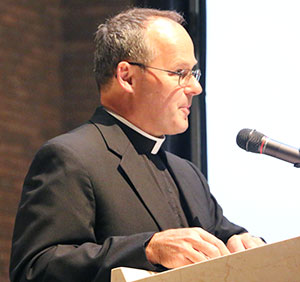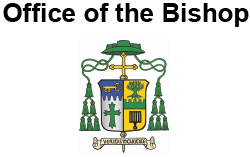Thoughts on the definitions of parish, church, secondary mission churches and more
Excerpts from the presentation Msgr. Edward Lohse, episcopal vicar for canonical services, offered as the final decisions for parish restructuring in the Diocese of Erie were announced. Additional definitions can be found on page 13 of the Parish Restructuring Preparation Guide.While we often use terms like church and parish interchangeable, it’s important that we understand what these terms mean, so that we’re all speaking the same language.
The first term is “parish.” The easiest thing to remember is that “parish equals people.” In the Code of Canon Law, canon 515 states that:
 Msgr. Edward Lohse According to canon law, a parish is a community of the faithful, and that community is clearly defined. Ordinarily, a parish community is defined geographically, so that the parishioners are technically all those people who live within its territory, just like we say that Pennsylvanians are all those people who live within Pennsylvania. A parish community can also be defined by some other objective method, like a common language or culture.
Msgr. Edward Lohse According to canon law, a parish is a community of the faithful, and that community is clearly defined. Ordinarily, a parish community is defined geographically, so that the parishioners are technically all those people who live within its territory, just like we say that Pennsylvanians are all those people who live within Pennsylvania. A parish community can also be defined by some other objective method, like a common language or culture. Who determines the criteria for a particular parish community? One person only ... the diocesan bishop. He divides, or if necessary re-divides, the diocese into parishes in the way that best helps him to provide for the care of souls.
Canon law also identifies for us the two types of parishes which will exist in the Diocese of Erie after February of next year ... the kind which has its own pastor, which we will call stand-alone, and the kind which shares a pastor with another parish, which we will call partnered.
A stand-alone parish is the traditional model, the one we normally think of when someone mentions a parish. It is a single community of believers, who have their own pastor whom they do not share with anyone, their own parish church, their own finances and finance council, their own parish pastoral council, and their own parish staff and office.
Although we are describing such a parish as a stand-alone, it is not a free agent. It is a part of the diocese, which is part of the Universal Church, and it receives its mission and vision from the Lord through the bishop.
The other type of parish is the partnered parish. Every partnered parish is still a canonically distinct community with its own members who have their own parish church, and their own finances and finance council. They will be asked to share some very important things with their partner parish, however: their pastor, their parish pastoral council, the parish office and staff.
Partnered parishes should respect each other’s unique identity while sharing and helping each other whenever possible.
They can share things like religious education programs, Lenten series, small Christian communities, evangelization efforts and outreach, etc. This will provide for a better stewardship of resources and personnel, relieve some of the financial burden on the parishes, and provide for a richer and more fruitful parish ministry.
We have done a lot of talking about merging. It is important to remember that merging is a transitional phase, not a final end. Every parish that merges will come out on the other side of the process as either a stand-alone parish or as a partnered parish.
This thought may be helpful: Merging is the process by which the bishop redefines the membership of a parish. He reorganizes a portion of the people of the diocese by bringing two communities together into a single entity, in order to provide better for the care of souls.
Here is a fundamental difference: Merging redefines the membership of a parish; partnering does not.
For this reason, every merger must be accompanied by a written decree of the bishop by which he formally redefines the parishes in question. The decree of the bishop for every merger occurring in the Diocese of Erie will be available on the diocesan website.
The partnering of parishes does not redefine them. There is no change in parish membership, no change in parish boundaries, etc. There are no decrees for parishes that are being partnered, because the membership of the parish communities isn’t actually being modified in any way.
The next important term is church. Just as “parish equals people”, we can say that “church equals building.”
The most important thing to note about the definition of church in the Code of Canon Law states is that the term church refers to a building, not to a parish community. In fact, sometimes the church and the parish don’t even have the same name.
Just as there are different types of parishes, there are also different types of churches.
The first type is the parish church, which is the principal church of a parish.
A parish church has certain rights and duties:
Every parish church must have the Eucharist reserved in the tabernacle, and for that reason every parish church must be open for at least some hours every day and Mass must be celebrated there at least once every two weeks. Why every two weeks? Because consecrated host are not to remain in the tabernacle more than two weeks before they are consumed and replaced.
A parish may also have one or two other churches in addition to the parish church. These are called secondary churches.
In the Diocese of Erie we have two types of secondary churches ... those with mission status and those without.
Only mission churches have permission for Mass on Sundays and holy days, or on the evenings preceding them.
In every secondary church, missions and non-missions alike, there is an obligation to celebrate Mass in the church at least once a year, and maybe twice: on the feast day of its title, and – if it was truly consecrated and not just blessed – on the anniversary of its consecration.
Beyond this, all secondary churches in the diocese are available for weddings and funerals, and at the discretion of the pastor they may also be available for other public devotions like novenas, Adoration and Benediction, the celebration of weekday Mass, etc. And of course, people can always enter simply to pray on their own whenever the church is open.

